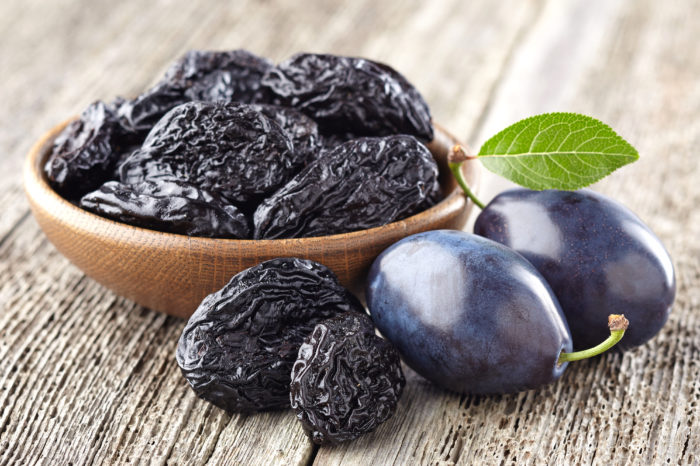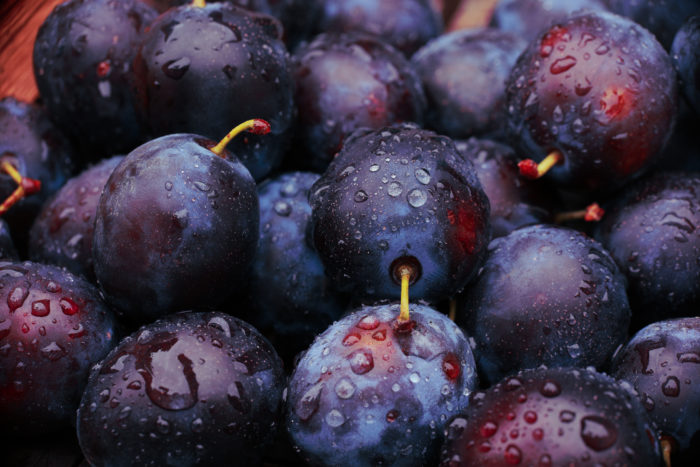
A comparison of prune vs plum can be very straightforward. After all, prunes are simply dried plums. That covers the basics, but there is more to the story. Not all plums can become prunes, so there’s a bit more finesse involved in differentiating these two products.
Well, let’s get to business and see what separates plums from prunes.
Prune vs Plum: Salient Points
Are Prunes Dried Plums?
The biggest difference between prunes and plums is that prunes are dried. Both of these are essentially the same thing, with the difference that prunes have been dried. Just like grapes become raisins on drying, plums become prunes.
However, not all varieties of plums are suitable for drying and turning into prunes. Commonly used varieties include European plums, American plums, and Japanese plums. Other varieties are usually not favored for turning into prunes and don’t quite give the best results.
Keep in mind, there are more than 2000 varieties of plums and they can differ in shape and size. Generally, plums are red and round when ripe, though varieties can have different colors and shapes.
In any case, prunes are dried plums. Though only specific varieties are preferable, you could characterize all dried plums as prunes.
What Is A Plum?

A plum is a fleshy and oval fruit with a pit (stone) at its center. They have a smooth and edible skin. The skin and fleshy part of the plum is edible, the stone is not and should be discarded when cooking or eating the plum.
Plums often have a white or silvery waxy substance on their skin. This coating is called the “bloom” and is a safe and edible part of the fruit. You can eat it without any problems.
There are several varieties of plum, and some of them can have different colors like yellow, green, or purple. Similarly, while the usual shape is oval, plums can have different shapes.
Plums are often consumed fresh, being eaten as a fruit. Or, they are used for cooking, various recipes, and jams.
The fruit is cultivated all around the world and has culinary uses everywhere. It is either eaten raw or in various recipes depending on the cuisine.
What Is A Prune?
A prune, as we know, is a dried plum. As the plums dry, they take on a smaller size and shrive up. Therefore, prunes have a darker color, wrinkled appearance, and are smaller than plums. As they dry, they give up the round (or spherical) shape of the plums and take on a relatively flatter and round appearance.
As they mature, prunes give up the red skin of the plums. Instead, they appear dark blue or purple, leaning towards black and darker hues.
Since they’re dried, they have a longer shelf life than fresh plums. While plums will only last a few days on the shelf or in the pantry, prunes can last for about six months.
Interestingly, as plums dry, the hold of the pit on the flesh of the fruit weakens. In prunes, it is very easy to remove the pit. Commercially available prunes often have the pits already removed.
On Nutrition And Benefits
Prunes and plums are rich in nutrition and offer several benefits. Plums are an excellent source of dietary fiber, carbohydrates, and several minerals. They’re also rich in Vitamin A, Vitamin B2, Vitamin C, and Vitamin K.
Since prunes are just dried plums, they have similar nutrition. However, the drying process apparently shakes things up a bit. Prunes are richer in Vitamin K, and also include Vitamins B2, B3, and B6.
Consuming prunes or prune juice is often recommended as a way to relieve constipation. The presence of a good amount of fiber in this food helps with constipation. Additionally, prunes contain a substance called sorbitol, which can act as a natural laxative. The combined effect of both these characteristics helps with constipation.
FAQ
Are Plums Good For You?
Plums are a wonderful fruit that’s very nutritious. They include a fair amount of dietary fiber, minerals, and vitamins A, B2, C, and K. The fruit is sweet and tart, with a good taste and is very enjoyable. If you don’t enjoy plums often, consider them one of the fruits you should eat more of.
Can Dogs Eat Plums?
The dietary fiber and sugar content of plums can make them useful for humans, but dogs can get a belly ache by eating it. A slice or two of plums or prunes won’t harm your dog and might even be helpful, but avoid feeding them too much or too often.
Some people point out that dogs shouldn’t eat plums because the pits are toxic. The pit isn’t edible, either for humans or for dogs. And really, what kind of a pet owner would feed pits to their dogs anyway!
Overall, dogs can consume the flesh and the skin of plums, though small quantities are preferable. Eating lots of plums or eating even small quantities often can cause stomach aches for dogs.
Does Prune Juice Make You Poop?
Prune juice is often seen as an effective remedy for constipation. For adults, drinking four to eight ounces of prune juice can prove helpful in relieving constipation. The fiber in the juice helps with stool movement, while its sorbitol content acts as a natural laxative.
Conclusion
A prune vs plum comparison shows us that the small differences can make significant changes. Though prunes are just dried plums, they have a different texture, taste, and a slightly different nutrition profile. Yet, both these are excellent foods and should be included in your diet.